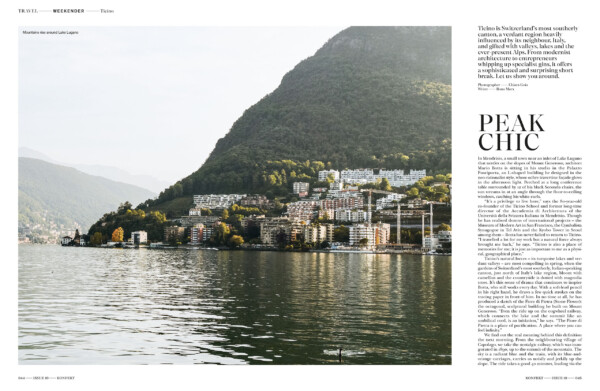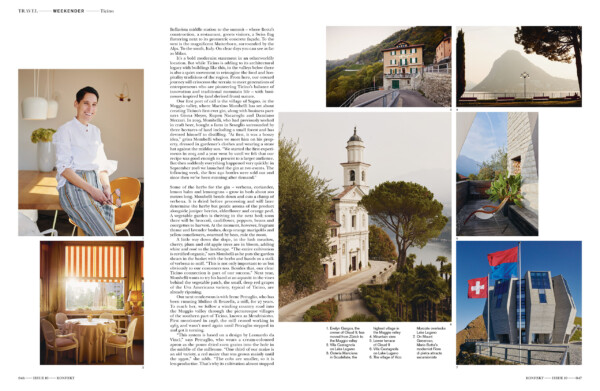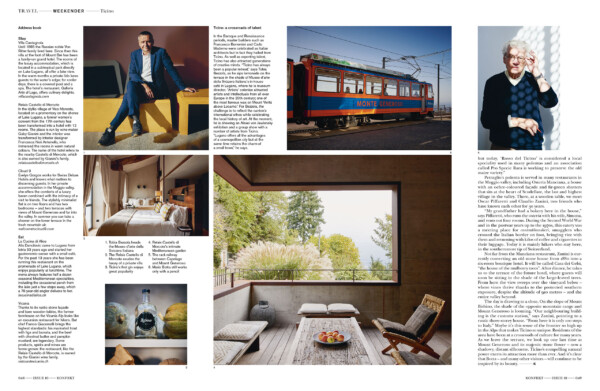Ilona Marx
Editorial work / Concepts / Texts
Best of both worlds
Travel
Ticino is Switzerland’s most southerly canton, a verdant region heavily influenced by its neighbour, Italy, and gifted with valleys, lakes and the ever-present Alps. From modernist architecture to entrepreneurs whipping up specialist gins, it offers a sophisticated and surprising short break. Let us show you around.
In Mendrisio, a small town near an inlet of Lake Lugano that nestles on the slopes of Mount Generoso, architect Mario Botta is sitting in his studio in the Palazzo Fuoriporta, an L-shaped building he designed in the neo-rationalist style, whose ochre travertine façade glows in the afternoon light. Perched at a long conference table surrounded by 12 of his black Seconda chairs, the sun streams in at an angle through the floor-to-ceiling windows, catching his white curls.
“It’s a privilege to live here,” says the 80-year-old co-founder of the Ticino School and former long-time director of the Accademia di Architettura of the Università della Svizzera Italiana in Mendrisio. Though he has realised dozens of international projects – the Museum of Modern Art in San Francisco, the Cymbalista Synagogue in Tel Aviv and the Kyobo Tower in Seoul among them – Botta has never failed to return to Ticino. “I travelled a lot for my work but a natural force always brought me back,” he says. “Ticino is also a place of memories for me; it is just as important to me as a physical, geographical place.”
Ticino’s natural forces – its turquoise lakes and verdant valleys – are most compelling in spring, when the gardens of Switzerland’s most southerly, Italian-speaking canton, just north of Italy’s lake region, bloom with camellias and the countryside is dotted with magnolia trees. It’s this sense of drama that continues to inspire Botta, who still works every day. With a soft-lead pencil in his right hand, he draws a few quick strokes on the tracing paper in front of him. In no time at all, he has produced a sketch of the Fiore di Pietra (Stone Flower): the octagonal, sculptural building he built on Mount Generoso. “Even the ride up on the cogwheel railway, which connects the lake and the summit like an umbilical cord, is an initiation,” he says. “The Fiore di Pietra is a place of purification. A place where you can feel infinity.”
We find out the real meaning behind this definition the next morning. From the neighbouring village of Capolago, we take the nostalgic railway, which was inaugurated in 1890, up to the summit of the mountain. The sky is a radiant blue and the train, with its blue-and- orange carriages, carries us noisily and jerkily up the slope. The ride takes a good 40 minutes, leading via the Bellavista middle station to the summit – where Botta’s construction, a restaurant, greets visitors, a Swiss flag fluttering next to its geometric concrete façade. To the west is the magnificent Matterhorn, surrounded by the Alps. To the south, Italy. On clear days you can see as far as Milan.
It’s a bold modernist statement in an otherworldly location. But while Ticino is adding to its architectural legacy with buildings like this, in the valleys below there is also a quiet movement to reimagine the food and hospitality traditions of the region. From here, our onward journey will crisscross the terrain to meet generations of entrepreneurs who are pioneering Ticino’s balance of innovation and traditional mountain life – with businesses inspired by (and derived from) nature.
Our first port of call is the village of Sagno, in the Muggio valley, where Martino Mombelli has set about creating Ticino’s first-ever gin, along with business partners Giona Meyer, Rupen Nacaroglu and Damiano Merzari. In 2019, Mombelli, who had previously worked in craft beer, bought a farm in Seseglio surrounded by three hectares of land including a small forest and has devoted himself to distilling. “At first, it was a boozy idea,” grins Mombelli when we meet him on his property, dressed in gardener’s clothes and wearing a straw hat against the midday sun. “We started the first experiments in 2015 and a year went by until we felt that our recipe was good enough to present to a larger audience. But then suddenly everything happened very quickly: in September 2016 we launched the gin at two events. The following week, the first 240 bottles were sold out and since then we’ve been running after demand.”
Some of the herbs for the gin – verbena, coriander, lemon balm and lemongrass – grow in beds about 100 metres long. Mombelli bends down and cuts a clump of verbena. It is dried before processing and will later determine the herby but gentle aroma of the product alongside juniper berries, elderflower and orange peel. A vegetable garden is thriving in the next bed; soon there will be broccoli, cauliflower, peppers, beans and courgettes to harvest. At the moment, however, fragrant thyme and lavender bushes, deep orange marigolds and yellow coneflowers, swarmed by bees, rule the roost.
A little way down the slope, in the lush meadow, cherry, plum and old apple trees are in bloom, adding white and rosé to the landscape. “The entire cultivation is certified organic,” says Mombelli as he puts the garden shears in the basket with the herbs and hands us a stalk of verbena to sniff. “This is not only important to us but obviously to our customers too. Besides that, our clear Ticino connection is part of our success.” Next year, Mombelli wants to try his hand at an aquavit: in the vines behind the vegetable patch, the small, deep red grapes of the Uva Americana variety, typical of Ticino, are already ripening.
Our next rendezvous is with Irene Petraglio, who has been running Mulino di Bruzella, a mill, for 27 years. To reach her, we follow a winding country road into the Muggio valley through the picturesque villages of the southern part of Ticino, known as Mendrisiotto. First mentioned in 1296, the mill ceased working in 1965 and wasn’t used again until Petraglio stepped in and got it turning.
“This system is based on a design by Leonardo da Vinci,” says Petraglio, who wears a cream-coloured apron as she pours dried corn grains into the hole in the middle of the millstone. “One third of our maize is an old variety, a red maize that was grown mainly until the 1950s,” she adds. “The cobs are smaller, so it is less productive. That’s why its cultivation almost stopped 6 but today, ‘Rosso del Ticino’ is considered a local speciality used in many polentas and an association called Pro Specie Rara is working to preserve the old maize variety.”
Petraglio’s polenta is served in many restaurants in the Muggio valley, including Osteria Manciana, a house with an ochre-coloured façade and fir-green shutters that sits at the heart of Scudellate, the last and highest village in the valley. There, at a wooden table, we meet Oscar Piffaretti and Claudio Zanini, two friends who have known each other for 30 years.
“My grandfather had a bakery here in the house,” says Piffaretti, who runs the osteria with his wife, Simona, and rents out four rooms. During the Second World War and in the postwar years up to the 1970s, this eatery was a meeting place for contrabbandieri, smugglers who crossed the Italian border on foot, bringing rice with them and returning with kilos of coffee and cigarettes in their luggage. Today it is mainly hikers who stay here, in the southernmost tip of Switzerland.
Not far from the Manciana restaurant, Zanini is currently converting an old stone house from 1880 into a six-room boutique hotel. It will be called Casa dei Gelsi, “the house of the mulberry trees”. After dinner, he takes us to the terrace of the future hotel, where guests will soon be sitting in the shade of the large-leaved trees. From here the view sweeps over the vineyard below – where vines thrive thanks to the protected southern exposure, despite the altitude of 910 metres – and the entire valley beyond.
The day is drawing to a close. On the slope of Mount Bisbino, the shade of the opposite mountain range and Mount Generoso is looming. “Our neighbouring building is the customs station,” says Zanini, pointing to a rustic three-storey house. “From here it is only 100 steps to Italy.” Maybe it’s this sense of the frontier so high up in the Alps that makes Ticino so unique. Residents of the area have been at a crossroads of culture for many years. As we leave the terrace, we look up one last time at Mount Generoso and its majestic stone flower – now a shadowy, distant silhouette. Ticino’s compelling natural power exerts its attraction more than ever. And it’s clear that Botta – and many other visitors – will continue to be inspired by its beauty.
Konfekt,
Spring 2023


